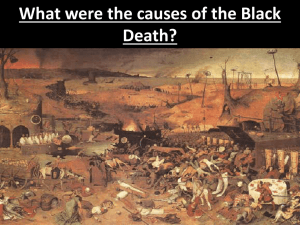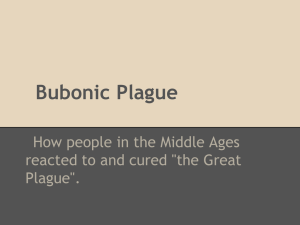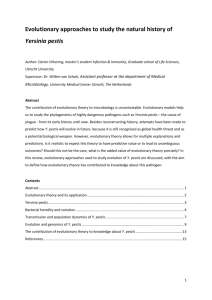POST TEST - Washoe County
advertisement
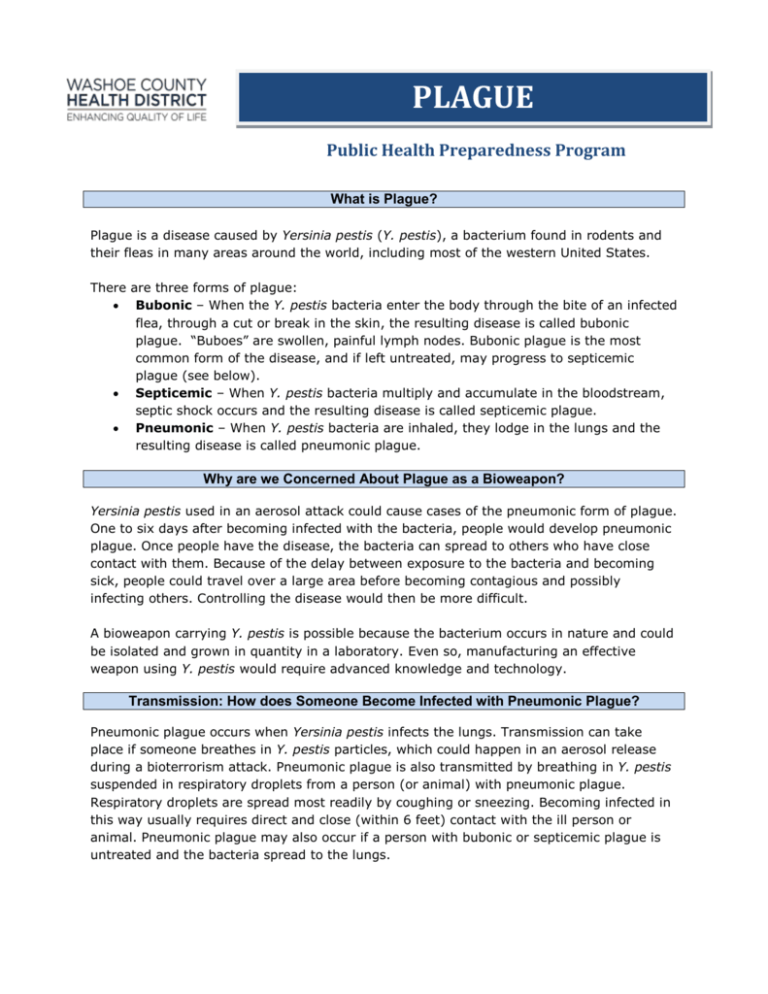
PLAGUE Public Health Preparedness Program What is Plague? Plague is a disease caused by Yersinia pestis (Y. pestis), a bacterium found in rodents and their fleas in many areas around the world, including most of the western United States. There are three forms of plague: Bubonic – When the Y. pestis bacteria enter the body through the bite of an infected flea, through a cut or break in the skin, the resulting disease is called bubonic plague. “Buboes” are swollen, painful lymph nodes. Bubonic plague is the most common form of the disease, and if left untreated, may progress to septicemic plague (see below). Septicemic – When Y. pestis bacteria multiply and accumulate in the bloodstream, septic shock occurs and the resulting disease is called septicemic plague. Pneumonic – When Y. pestis bacteria are inhaled, they lodge in the lungs and the resulting disease is called pneumonic plague. Why are we Concerned About Plague as a Bioweapon? Yersinia pestis used in an aerosol attack could cause cases of the pneumonic form of plague. One to six days after becoming infected with the bacteria, people would develop pneumonic plague. Once people have the disease, the bacteria can spread to others who have close contact with them. Because of the delay between exposure to the bacteria and becoming sick, people could travel over a large area before becoming contagious and possibly infecting others. Controlling the disease would then be more difficult. A bioweapon carrying Y. pestis is possible because the bacterium occurs in nature and could be isolated and grown in quantity in a laboratory. Even so, manufacturing an effective weapon using Y. pestis would require advanced knowledge and technology. Transmission: How does Someone Become Infected with Pneumonic Plague? Pneumonic plague occurs when Yersinia pestis infects the lungs. Transmission can take place if someone breathes in Y. pestis particles, which could happen in an aerosol release during a bioterrorism attack. Pneumonic plague is also transmitted by breathing in Y. pestis suspended in respiratory droplets from a person (or animal) with pneumonic plague. Respiratory droplets are spread most readily by coughing or sneezing. Becoming infected in this way usually requires direct and close (within 6 feet) contact with the ill person or animal. Pneumonic plague may also occur if a person with bubonic or septicemic plague is untreated and the bacteria spread to the lungs. What are the Signs and Symptoms of Pneumonic Plague? Patients usually have fever, weakness, and rapidly developing pneumonia with shortness of breath, chest pain, cough, and sometimes bloody or watery sputum. Nausea, vomiting, and abdominal pain may also occur. Without early treatment, pneumonic plague usually leads to respiratory failure, shock, and rapid death. How Soon do Infected People get Sick? Someone exposed to Yersinia pestis through the air – either from an intentional aerosol release or from close and direct exposure to someone with plague pneumonia – would show symptoms within 1 to 6 days of exposure. How is Pneumonic Plague Treated? Prompt treatment with the correct medications is critical to prevent complications or death. To prevent a high risk of death, antibiotics should be given within 24 hours of the first symptoms. You should use antibiotics to prevent or treat plague only under the direction of your health care provider or local health department. Several types of antibiotics are effective for curing the disease. Drugs of choice are streptomycin or gentamicin antibiotics for injection or intravenous use. Available oral medications are tetracyclines (such as doxycycline) or fluoroquinolones (such as ciprofloxacin). Early in the response of a bioterrorism attack, these drugs would be tested to determine which is most effective against the particular weapon that was used. Can a Person Exposed to Pneumonic Plague Avoid Becoming Sick? Yes. People who have had close contact with an infected person can greatly reduce the chance of becoming sick if they begin treatment within 7 days of their exposure. Treatment consists of taking antibiotics for at least 7 days. Would Enough Medication be Available in the Event of a Bioterrorism Attack? Yes. National and state public health officials have large supplies of drugs needed in the event of a bioterrorism attack. These supplies can be sent anywhere in the United States within 12 hours. What is the Washoe County Health District Doing to Prepare for a Plague Outbreak? In the event of a weaponized pneumonic plague attack or outbreak, the Washoe County Health District will announce detailed instructions on how to obtain preventive medication through a point of dispensing (POD) site. This information will be available through the media and the Washoe County Health District website. Source: www.cdc.gov

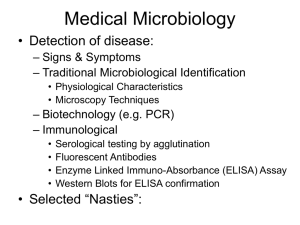
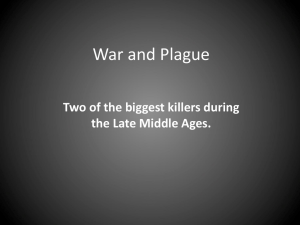
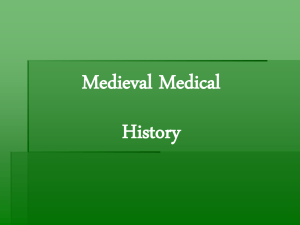
![[Presentation by Sara Morgans].](http://s2.studylib.net/store/data/005578977_1-95120715b429730785aca2fdba9a2208-300x300.png)
